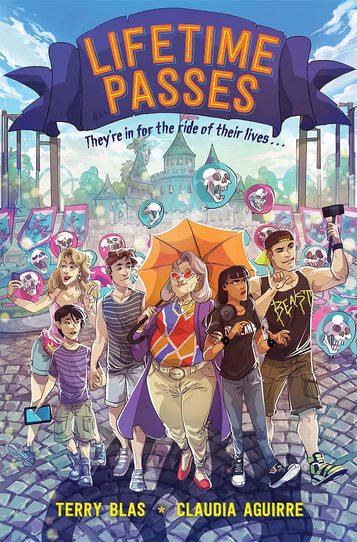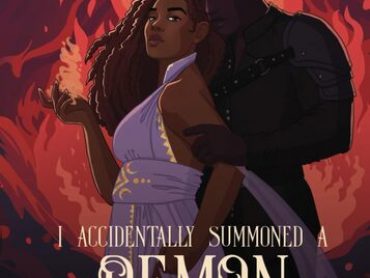Terry Blas is the author of Lifetime Passes. Lifetime Passes is a graphic novel that was written by Terry and illustrated by Claudia Aguirre. The novel follows a group of teens that start a program to bring senior citizens to a local theme park to take advantage of the unofficial park policy: If someone dies on the property, the rest of their party is given lifetime passes! YEM was able to speak with Terry about the process of writing a graphic novel, what he wants his readers to take away from reading it, and how long the process took.
Young Entertainment Mag: Do you remember the first time you knew you wanted to write?
Terry Blas: I’ve always created characters and stories for them so I’ve been doing that since I was a kid. But I dedicated myself to writing in my career about ten years ago when I grew frustrated with my technical drawing abilities while making comics.
YEM: You wrote the graphic novel Lifetime Passes, what can you tell us about it?
Terry: It’s about a young girl named Jackie whose parents have been deported. She’s obsessed with her local theme park, Kingdom Adventure and when she can’t afford a pass any more and hears that if a member of your party dies while at the park then the rest of you party will receive lifetime passes, she and her friends decide to form a fake senior citizen outreach program to take the elderly to the park in the hopes that while there one of them might…die. Of course, nothing goes according to plan.
YEM: Lifetime Passes is described as darkly comedic, what is your favorite part of writing stories in this genre?
Terry: I love pulling the rug out from under a reader. Convincing them that they are reading one type of story and having it be revealed to be another. I think people think comedy can’t be touching or heartwarming but I think more and more we are seeing stories that combine so many things. Comedy, drama, horror, action etc. I love combining all of those things.
YEM: What is the process of writing a graphic novel like?
Terry: I guess it depends on the graphic novel. I typically come up with the idea, develop it over time by developing the characters and story and then work on a synopsis. From there I write a technical script, since comics are a visual medium. Then the process turns to the art where layouts, pencils, inks, colors, letters, design all happen. They are a very collaborative process.
YEM: What is your favorite part of writing graphic novels?
Terry: The collaboration with editors who help strengthen your story and with artists who bring that to life. It’s always exciting.
YEM: Claudia Aguirre collaborated with you as the illustrator of Lifetime Passes, what was this collaboration like?
Terry: We did another book together that we love called Hotel Dare. So we go back a ways and we are really close. I love collaborating with her and she always elevates what I write to such a higher level. I trust her completely and she instinctively knows what I want as well.
YEM: You are also an illustrator. What do you enjoy most about illustrating?
Terry: I love drawing portraits and animals. Characters really. I do like drawing comics but when you draw comics you have to be able to draw everything and I just really am not great at drawing buildings and bikes and cars and all that. Or even perspective. I don’t know, that’s why I do more writing now and I love it. I still draw plenty.
YEM: How do you decide which projects you are going to write versus which you are going to illustrate?
Terry: There aren’t too many comics projects that I consider drawing now. So that really helps. I personally love writing a book, then writing the next one while the art for the previous book is being done.
YEM: What is something you want your readers to take away after reading Lifetime Passes?
Terry: I hope they take away that the elderly and the young have more in common than we think. I remember an old episode of the Simpsons where Lisa and Grandpa are sitting at the kitchen table and Lisa says: “When you’re a kid nobody listens to you.” And then Grandpa says: “When you’re old nobody listens to you.” And neither one of them is listening to the other. That was such an interesting moment to me, to see that these two groups, children and the elderly, have more in common than we realize, and the bonds that they have can be really strong. Jackie, who has lost her parents to deportation and is a DACA kid, doesn’t have a relationship with her own grandparents. She’s never even met them because she can’t go back to Mexico, so at first she doesn’t know how to even be around Phyllis and when Jackie begins to open up, she sees that she has more in common with and feels more understood by this old woman than by her teenage friends.
YEM: What advice do you have for those who aspire to become writers?
Terry: To treat it like a job. To study the craft of writing and to read as many books as you possibly can.
YEM: Where did the inspiration for Lifetime Passes come from?
Terry: I lived in Southern California for a while and noticed the obsessive culture around theme parks. I also had friends who had worked at several theme parks and the wild stories they told me seemed too good to not have a story built around them. That’s really how it began.
YEM: How long was the process of making this graphic novel?
Terry: I came up with the idea at least 17 years ago. I thought about it for a long time and once I refined it and pitched it to different companies things happened relatively quickly. I took several months to write and refine the synopsis and then once I had that to where I wanted, I wrote the script in just a few months. We go through a few edits of that and then the art starts. Claudia is amazing and very fast. The whole process is always different depending on the project and the company.





